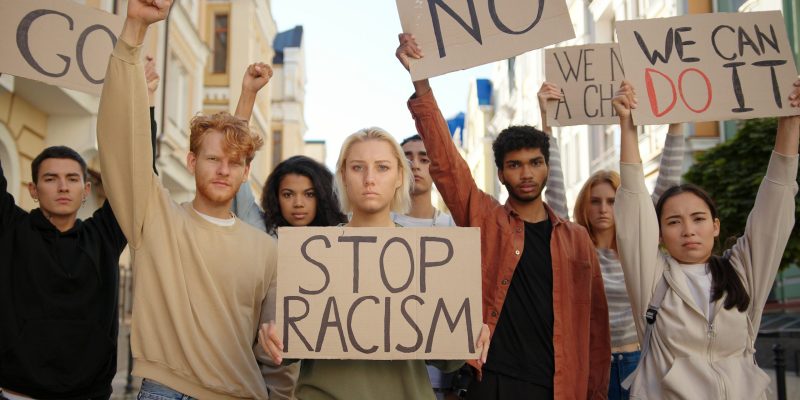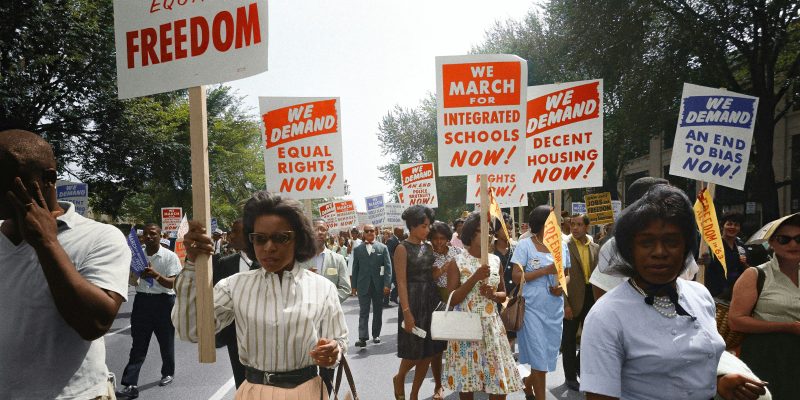We explain what racism is and what types of racism exist. Also, what is its relationship with discrimination and what is prejudice.

What is racism?
Racism is the belief in the existence of superior and inferior races of human beings. It can be part of the prejudices or personal convictions of some people or manifest in political and social actions promoted by parties or governments.
The basis of racism is the idea that humanity is divided into races. This idea is accepted by some scientists but rejected by others, who prefer to talk about ethnic groups, since they consider that physical aspects do not mark significant differences between people (that is, that there are no different human races) and that cultural forms are the that really differentiate human groups. In any case, racism involves valuing races or ethnic groups and, therefore, entails different forms of preference, segregation or exclusion based on skin colorfacial features, ethnic identity or cultural origin.
Racism often leads to discriminatory practices, such as the granting of privileges (social, economic, legal, political) to one ethnic group over others, the separation, marginalization or violent attacks against certain populations, or the refusal or even prohibition of associating with people from other ethnicities.
This phenomenon is known as racial discrimination and is part of hate crimes and crimes typified in numerous international conventions that defend equality between people.
Racism has a long history. Some scholars identify its origins in different forms of ethnocentrism and xenophobia that existed since ancient times. Others consider it to be a more modern phenomenon, linked to the racial classification of Western scientific thought of the 18th and 19th centuries.
Racism reached its peak in the era of the European colonial empires and the Arab slave trade. This involved the enslavement of millions of people originating from the African continent and their descendantsand their subjection to multiple forms of discrimination and violence even after the abolition of slavery (for example, in the United States).
Other significant episodes were the pogroms against Jewish populations in Europe in the 19th and 20th centuries and, especially, the Holocaust perpetrated by the Nazi regime in Germany and the territories that made up the Third Reich until its defeat in the Second World War (1939-1945).
Currently, the fight against racism occurs at different levels, both local or community, state and international. For example, the United Nations (UN) stated in the 1948 Universal Declaration of Human Rights that Human rights apply to all people “without distinction of race.”color, sex, language, religion, (…) national or social origin (…)”, among other characteristics. On the other hand, in 1965 it adopted the International Convention on the Elimination of All Forms of Racial Discrimination, and in 1966 it established March 21 as the International Day for the Elimination of Racial Discrimination.
Key points
- Racism is the belief in the existence of superior and inferior human races and the discrimination exercised based on this belief.
- It is usually based on physical differences (such as skin color) or cultural differences (such as ethnicity or traditions).
- It manifests itself through personal prejudices or political actions, and can lead to the segregation or exclusion of certain ethnic groups.
- There are different forms of racism, such as cultural, biological, institutional, aversive, hidden and positive racial discrimination.
Types of racism
There are different forms of racism:
- Cultural racism. It consists of the rejection or denigration of the cultural traditions of an ethnic group considered “inferior” or “dangerous,” as opposed to one's own culture, which is identified as “superior” or “correct.” Although what is rejected are cultural practices, these are usually equated with the ethnic or “racial” origin of the people who practice them.
- biological racism. He maintains that there are biologically superior and inferior races, and that the superior ones are destined to dominate the inferior ones. In addition to identifying some peoples as inferior, it usually defines miscegenation as a “mixture” of races that generates impurity and threatens “racial purity.” This type of racism was largely abandoned following the crimes committed by the Nazi regime in the 1940s.
- Institutional racism. It is the application, by State institutions, of measures that are based on racial discrimination. This occurs, for example, when justice acts differently depending on the citizen's skin color, or when racist practices are normalized within the police, as is the case in certain states in the United States. A particular form of institutional racism was apartheid in South Africa, a legal system of racial segregation that favored the “white minority.”
- Positive racial discrimination. It consists of promoting policies that favor individuals who belong to an ethnic group that is frequently discriminated against, as compensation for being victims of discrimination or for other reasons. The objective is to facilitate their access to jobs, studies or public positions. For example, when quotas are established for members of a certain ethnicity at a university.
- aversive racism. This is a form of racism and subtle xenophobia. It usually manifests itself in the distance or coldness assumed in front of people of other ethnicities, or in the formation of prejudices without these motivating violent or aggressive actions.
- Hidden racism. It is a form of non-explicit discrimination, which legitimizes racism indirectly by not reporting discriminatory practices, or which excludes people belonging to certain ethnic minorities from certain areas of sociability, employment or education without making it explicit.
Racism and discrimination

Discrimination is the unequal treatment offered to some people or others for various reasons. Sometimes, it causes the emergence of social movements that fight against it. Racism is one of the most common forms of discrimination. However, it is not the only one. Other forms of discrimination include:
- Xenophobia. It is the fear, contempt or hatred towards foreigners, which usually promotes different forms of discrimination, such as the refusal to live with those who come from other countries. The clearest manifestation is discrimination, and even aggression, against immigrants.
- Homophobia. It is the rejection or hatred towards homosexual people or towards the very existence of homosexuality, which is defined as a perversion or a type of unnatural relationship. Discrimination can be institutional in nature, denying rights to homosexual people (for example, same-sex marriage), or include acts of physical or verbal violence.
- religious discrimination. It is the aversion towards certain religions or towards their followers, or in some cases towards all religions other than one's own. For example, following the terrorist attacks committed by radicalized jihadist groups in some Western cities at the beginning of the 21st century, the equation between Islam and terrorism became frequent, which led to acts of discrimination against many Muslims. On the other hand, anti-Semitism is a type of discrimination that is directed against the Jewish people, understood as an identity that is both ethnic and religious.
Prejudice

A prejudice is a opinion, evaluation or position on a topic, a person or a human group that is assumed in advancethat is, before knowing the subject or the people enough to form an accurate judgment about them.
Generally, this is an unfavorable opinion or judgment. In this sense, people who prejudge have preconceived ideas about people, ethnicities or places that they do not know but that they assume to be true, and act based on them. This gives rise to mistrust, fear, rejection and, often, discrimination against people based on ethnicity or nationality.
References
- Bobbio, N., Matteucci, N. and Pasquino, G. (Dirs.). (2015). Politics Dictionary. 21st century.
- Geulen, C. (2010). Brief history of racism. Alliance.
- United Nations. (1965). International Convention on the Elimination of All Forms of Racial Discrimination. Office of the United Nations High Commissioner for Human Rights. https://www.ohchr.org/
- Smedley, A. (2024). Racism. Encyclopedia Britannica. https://www.britannica.com/





